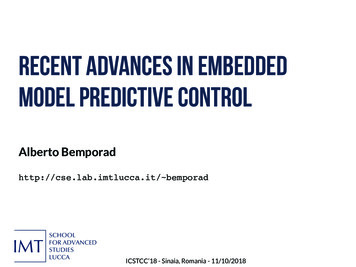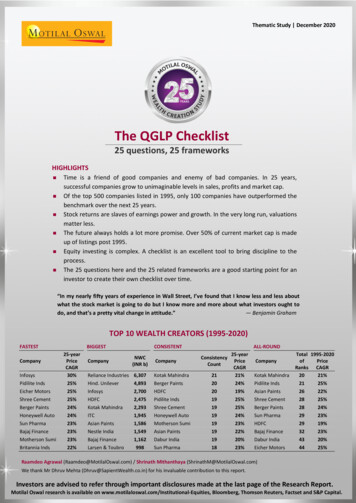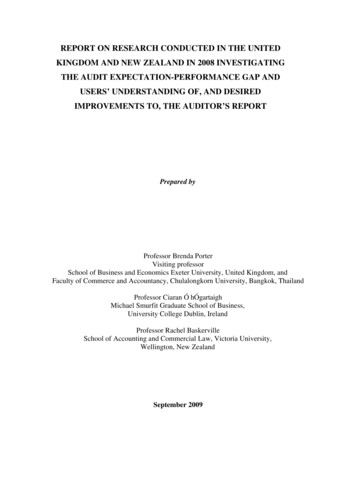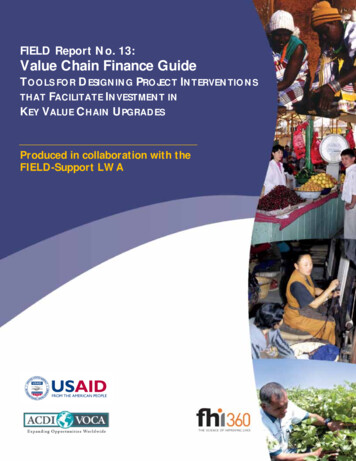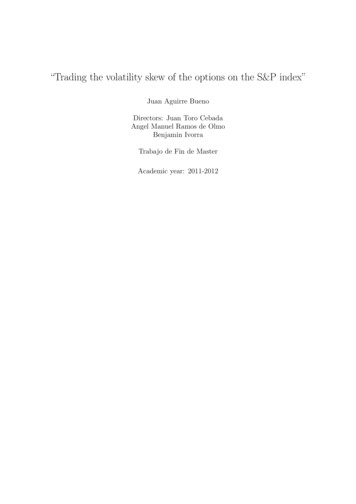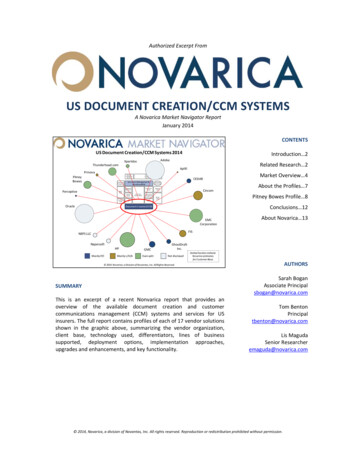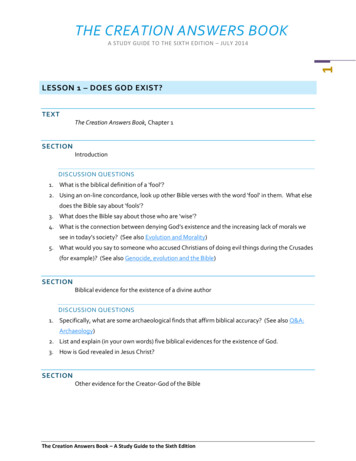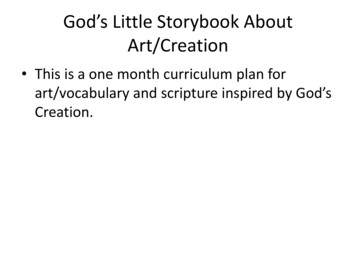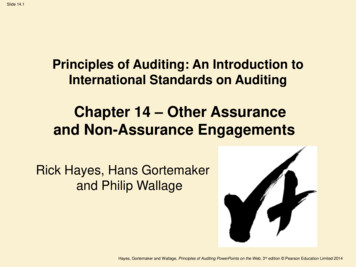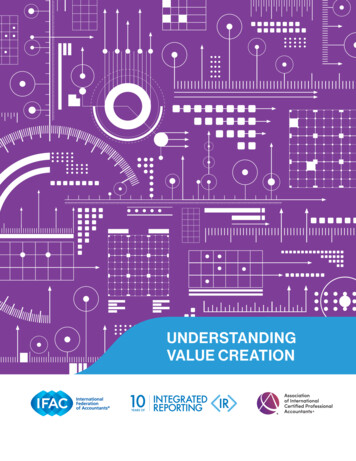
Transcription
A VISION FOR THE CFO & FINANCE FUNCTIONUNDERSTANDINGVALUE CREATION
Exposure Drafts, Consultation Papers, and other IFAC publications are published by,and copyright of, IFAC.IFAC does not accept responsibility for loss caused to any person who acts or refrainsfrom acting in reliance on the material in this publication, whether such loss is causedby negligence or otherwise.The IFAC logo, ‘International Federation of Accountants’, and ‘IFAC’ are registeredtrademarks and service marks of IFAC in the US and other countries.Copyright 2020 by the International Federation of Accountants (IFAC). All rightsreserved. Written permission from IFAC is required to reproduce, store or transmit, orto make other similar uses of, this document, save for where the document is beingused for individual, non-commercial use only. Contact permissions@ifac.org.ISBN: 978-1-60815-419-7
UNDERSTANDING VALUE CREATIONCONTENTS3Understanding Value Creation4Defining Value5Creating Value7Delivering Value9Sustaining Value11
UNDERSTANDING VALUE CREATIONUNDERSTANDINGVALUE CREATIONThis report supplements The CFO and FinanceFunction Role in Value Creation.Before being able to measure, track and communicate onvalue creation, it is important to understand value creationand enable a value creating business model.DEFINECREATEThis can be achieved through a management process ofdefining, creating, delivering and sustaining value. Valueis ultimatelyVALUE Defined by customers, investors and otherstakeholders Created through the organization’s purpose,strategy, and business model taking into accountall resources, capitals, and relationships in anintegrated way Delivered to ever-more demanding andsophisticated stakeholders through responsibleproducts and services, and through new channels,at an appropriate price Sustained by retaining and protecting valueinternally, and by appropriate reinvestment anddistribution to shareholders and wider society.Each of these areas informs strategy, goals, metrics,and incentives.Additional resources on value creation from theglobal accounting and business communities areavailable here.4SUSTAINDELIVER
UNDERSTANDING VALUE CREATIONDEFINING VALUEHow value is defined is by customers, investors, employees, suppliers and other stakeholders. Valueitself, as well as priorities for value creation, are defined in the context of meaningful engagement withkey stakeholders, and opportunities and threats facing the organization. These inform an organization’spurpose, values, strategy and measures of success.Defining value involves establishing and prioritizingstakeholders, understanding how they are relevant tothe organization’s purpose and strategy, and assessinghow to balance their respective needs and expectations.Effective stakeholder engagement allows a breadth ofperspectives from different stakeholders to inform onthe issues which are most pertinent to the resilience ofthe business and critical to its long-term success. Forexample, ABN AMRO N.V. discloses its value-creatingtopics based on a full assessment of its operatingenvironment and stakeholder engagement, as wellas where it believes it can create most value forstakeholders and society.Stakeholder engagement needs to be meaningfuland frequent to add value to decision making andcapital allocation. AA1000 Stakeholder EngagementStandard (AA1000SES) 2015 provides practicalguidance on how to assess, design, implement andcommunicate effective stakeholder engagement,as well as how to enable stakeholders as activecontributors to value creation. Meaningful engagementwith key stakeholders enhances understanding ofthe positive and negative impacts of doing business,and consequently informs a continuous assessmentof the material issues informing strategy and itsimplementation through the activities in thebusiness model.5The process of defining value through engagement alsohelps to reveal areas of misalignment and trade-off. Forexample, in capital allocation, investors might prefer theshort-term deployment of capital, whereas the boardmight prefer long-term projects. Consequently, it isimportant to understand and communicate how shortterm expectations from different stakeholders mightinfluence long-term choices and prospects. This providesthe basis for communicating how short-, medium-, andlong-term trade-offs are managed.Leveraging data is an important part of identifyingvalue creation drivers. Understanding and properlymanaging data across the business is crucial for CFOsto create better stakeholder outcomes.
UNDERSTANDING VALUE CREATIONDEFINING VALUE—KEY QUESTIONSWhat are the relevant issues in the contextof the changing external environment thatneed to be considered in decision makingand capital allocation?Who are our key stakeholders and howare they relevant to our purpose and valuecreation? This involves Prioritizing stakeholders and theirlegitimate needs, expectations andpreferences Identifying what outcomes are neededto deliver stakeholder expectations Establishing whether purpose, valuesand strategy fulfil relevant stakeholderoutcomes.Do we have a process in place forstakeholder engagement and understandingand prioritizing the significant opportunitiesand challenges facing the business?What are the value propositions that meetthe needs of high priority stakeholders,and the strategic assets and capabilities(i.e., those that generate benefits and aregenerally difficult to imitate) that form thebasis of delivering value?What are the areas of potential conflictand trade-offs among stakeholder interests,including within stakeholder groups (e.g.,providers of equity versus debt)?6CONNECTING PURPOSE TO STAKEHOLDEROUTCOMES AND MEASURES OF SUCCESSFor an increasing number of companies, their purpose isfocused on delivering value to customers, stakeholdersand society through their products and services.Connecting purpose to stakeholders and their desiredoutcomes provides a basis for measuring success.Example: Purpose“Enhancing quality of life and contributingto a better working world through ourinnovative products”What are the desired outcomes for each stakeholder ifthe purpose is fulfilled? Society: Improved well-being through healthierliving, and longer life Employees: Innovative working environment, andimproved well-being from work Investors: High dividends as a result of innovativeproducts Customers: Reduced healthcare expenditureresulting from healthier population Government: Healthier population resulting inincreased productivity and improved well-being.Reference: the Embankment Project for InclusiveCapitalism
UNDERSTANDING VALUE CREATIONCREATING VALUEHow value is created through the organization’s purpose, strategy and business model taking into accountall resources, capitals, and relationships in an integrated way.The value creation process is at the heart of integratedthinking and value creation. Strategically, the businessmodel is a central cog in the value creation processwhich turns valuable resources and relationships (inputs)into results (outputs) that create value for stakeholdersand society (outcomes and impacts). Value for customersand other stakeholders is ultimately created or destroyedthrough the business and operating model.ContentsIntroductionAbout us and our WhyOur resultsGovernanceInputMany organizations undertaking integrated reportingusing the International Integrated ReportingFramework to set out their value creation and businessmodel as a central part of their integrated reporting. Thisapproach provides a tool to connect purpose, strategyand the value creation process across relevant capitals,outcomes and impacts. An example is Royal SchipholGroup which includes an explanation of its valuecreation2019.Socio-economic accountabilityFinancialmodelStatements in its Annual ReportRoyalSchiphol Group - 2019 Annual ReportOutputAdded valueDestination3Infrastructure capital– Airside– Landside– ITmWhyConnectingyour world4Our Vision 20501AmbitionCreating the world’s mostsustainable, high quality airports– Network ofdestinations– AccessibilityCO2 emissions– CO2 and airquality– Sustainableaviation– Circular economyReputation score– Noise– Community andsupport baseOn-timePerformance– Airport capacity5Quality of LifeNet PromoterScore– CustomerappreciationSafety Index– Safety & securityEmployeePromoter Score– EmploymentpracticesReturn on Equity1– Businesscontinuity– Responsiblebusiness– Financial solidity6.56Intellectual capital66.5%7Business areasNatural capital– Energy– Raw materialsQuality of Service8Financial capitalAviationStakeholderslocal residentsairlinespassengersKey risksConsumerProducts andServicesRealEstateTrends &DevelopmentsAlliances &Participations36130%Governance7.8Safety & Robustorganisation8.3%employeesshareholders1 Normalised ROE: 5.5%Reference: Royal Schiphol Group, Annual Report 20197Wellbeing– Connecting– Environmentalimpact andhindranceQuality of Network169 KtHuman capitalOutcome & ImpactMaterial aspectsICA destinations138Business modelSocial capitalTop Performance Indicators5Prosperity– Businessclimate– Regionaldevelopmentand jobsUN SustainableDevelopment Goals(SDGs)
UNDERSTANDING VALUE CREATIONThe Royal Schiphol Management Agenda aligns alladded value activities within the Group to eight topperformance indicators across five key stakeholdergroups: local residents, passengers, airlines, employeesand shareholders (their process is further highlighted inUnderstanding and Communicating Value Creation,page 6). Another example, is the ABN AMRO valuecreation model in its Integrated Annual Review2019, which also connects to the impacts of its bankingactivities set out in its Impact Report 2019.In many industries and sectors, business models arebeing disrupted through, for example, technologicaladvancements and digitization, resource depletion,climate impacts or other societal changes that involvesubstantial business and operating model rethinking.The capacity of the business model to adapt to changes(e.g., in the availability, quality and affordability of criticalresources or capitals) is likely to affect a company’slonger-term resilience and viability.Ensuring that value is created over time involves makingsignificant decisions on where the business competes(e.g., markets, geography, segments), identifyingthe principal opportunities and risks related to thestrategy and business model, ensuring products andservices meet customer needs and respond to societalchallenges, and collaborating with critical partners invalue creation. To create long-term value, organizationsneed to put in place the infrastructure, capability andrelationships (tangible and intangible assets) thatenable them to meet the needs of their customers andstakeholders.Consequently, capital and resource allocation decisionsare a critical part of how value is created and sustained.Investments in capital maintenance and developmentof strategic assets and capabilities such as talent,innovation, infrastructure, brand and intellectual assetsenable value to be created. They need to be consideredbeyond estimated financial returns and in the context ofinternal and external stakeholder outcomes, and a widerset of impacts.CREATING VALUE—KEY QUESTIONSHow is value to be created through thestrategy and business model considering allcapitals and resources in an integrated way? Where do we compete (product/servicesegments, regions/territories, segments?) What are the principal opportunities andrisks related to the business model? How are resources procured andtransformed to deliver value and whatchanges are needed to ensure a resilientand sustainable business model? How do products/services meet customerneeds and respond to societal challenges? Who are our critical partners andcollaborators in value creation?8How do we balance the achievement ofvalue creation objectives against all potentialimpacts? How are resources allocated to meetobjectives and trade-offs betweenstakeholder interests managed? What tools and approaches enable us toincorporate additional forms of analysis incapital allocation and investment decisions,such evaluations of external impacts, socialimpacts (e.g., health and safety or laborpractices), economic impacts of decisions(e.g., for communities and suppliers), andenvironmental impacts (e.g., biodiversityand pollution)? What are the key strategic, operational andfinancial value and performance metricsand indicators that need to be captured?
UNDERSTANDING VALUE CREATIONDELIVERING VALUEHow value is delivered to customers and society through responsible and profitable products, services, andchannels to market. This involves understanding and leveraging strategic and intangible assets to delivervalue in new and more effective ways. It also requires delivering value at an appropriate price, cost, andlevel of performance. Delivering value requires integrated and relevant strategic, operational, and riskinformation that takes into account the changing external environment and ensures that performance isaligned to business and value creation objectives.Delivering value involves doing things right in terms ofdelivering responsible products and services to the rightstakeholder at the right time, place and price. Value canonly be delivered when products and services and otheroutputs from the business model deliver stakeholderoutcomes as well as long term economic profitability.To deliver value therefore involves effective decisionmaking processes, including profitability planningand improvement and project appraisal. These areenabled by an enterprise performance managementapproach that provides the necessary informationaround resources and processes, revenue, costs and risksin the context of business and value objectives.Organizations deliver value by providing products andservices to customers that meet their, and society’sneeds, at a price they are prepared to pay. To achievethis, the CFO and finance team need to understand thebusiness including different customer segments, thechannels to reach each segment, and the key resourcesand processes that underpin value delivery many ofwhich will be intangible and not reflected in accountinginformation, such as sales, marketing, research anddevelopment, production, logistics and financing.CFOs and their teams need to capture revenue andcost models based on an operational perspective ofthe business to help support the delivery of value. Thismodeling also needs to incorporate environmental,social and governance (ESG) factors which coverenvironmental or social performance and impacts,9and broader governance issues related to conductingbusiness responsibly. These models are an importantbasis for understanding and capturing value, makingdecisions, and deciding where to invest and how afinancial surplus is distributed and used.Accounting for resources and costs reflects levels ofactivity, channels to market, the efficiency of processes,and resources consumed by activities, as well as pricespaid for resources.Resource allocation decisions need to incorporate thosecosts and benefits that are external to the organization(i.e., those that accrue to society or to identifiablethird parties). External impacts can be internalizedby incorporating appropriate costs and benefits intothe decision-making process. Approaches such asenvironmental management accounting, full costaccounting (FCA), lifecycle assessment, and costing orwhole life costing, and enterprise risk management helpto identify and quantify costs and benefits, and risksand opportunities related to both current and futurestrategies and operations. These approaches bringin important additional forms of analysis, includingevaluations of social impacts (e.g., health and safety orlabor practices), economic impacts of decisions (e.g.,for communities and suppliers), and environmentalimpacts (e.g., biodiversity and pollution). Such impactswill relate to the identification and quantification of cashand non-cash costs and benefits accruing to both theorganization and to others.
UNDERSTANDING VALUE CREATIONNEW WAYS OF DELIVERING VALUE TO CUSTOMERSAND KEY STAKEHOLDERSThe way value is delivered is also changing rapidly dueto changing business models in the digital economy thatreinvent channels to market, and production methods(e.g., industry 4.0). Digital manufacturing provides hugeamounts of data that can enable a better understandingof how to deliver value in new ways to meet unmetneeds and desires.Many organizations are undertaking digitaltransformational enhancements involving data, artificialintelligence (AI) and machine learning capabilities tofacilitate their digital transformation. This can relateto all aspects of the business model including newdigitally enabled processes, AI and machine learningto drive information insights, speed and accuracy, andtechnology driven products and services.DELIVERING VALUE—KEY QUESTIONSHow do we deliver value to customers andsociety through our products and services,and channels to market?How can technology, digital and data help usdeliver value?How do we deliver value to customers andsociety profitably and sustainably?Are the customers of the finance functionincluding the board, management andoperations receiving the necessary revenue,cost and risk information to evaluate theachievement of value objectives?Where and how are capital and resourcesallocated to deliver strategic and valueobjectives?ENABLING THE ACCOUNTANT’SROLE IN EFFECTIVE ENTERPRISERISK MANAGEMENTThe Role of the FinanceFunction in EnterprisePerformance ManagementEnabling the Accountant’s Role in EffectiveEnterprise Risk Management (ERM)As businesses face rapid change and increasinguncertainty, there are three ways in which CFOs andfinance functions can ensure ERM links to managing forvalue creation: Align risk management with value creation andpreservation; Drive insights and enable decisions through provisionof risk modeling and analytics, data governance andidentification of organizational risk appetite; and Enable integration and interconnectivity by breakingdown siloes across the organization to shareinformation.Identifying the Role of the Finance Function inEnterprise Performance Management (EPM)For finance professionals to be viewed as businesspartners, they must contribute effectively to EPM beyondtraditional financial reporting and financial systems.This report identifies how the finance function mustevolve to support EPM, including: How EPM supports all levels of an organization tosupport value creating decisions, from daily issues onoperational efficiency and customer service to majorstrategic shifts of direction; How accountants in business and the financefunction can drive effective EPM; and The four key enablers of EPM.10
UNDERSTANDING VALUE CREATIONSUSTAINING VALUEHow value is sustained by retaining and protecting value internally in the organization and distributingvalue externally to shareholders and stakeholders. Ideally, there needs to be a balanced approach betweenthe retention of value derived by the organization and the distribution of value to its stakeholders alignedto purpose and value objectives.Sustaining value and trust in the organization involvesactions and communication on both value createdand protected through the stewardship of tangibleand intangible assets, and financial and non-financialperformance. In sustaining value, CFOs and their teamsfulfil value protection and stewardship by ensuringtransparency and accountability including fair andbalanced presentation of value creation related to bothgrowth and value-creating opportunities in the contextof stakeholder expectations and market changes, andefforts to protect value and safeguard critical financialand non-financial assets.Adequately sharing the benefits of value creation helpsto create trust and incentivizes key stakeholders tocontinue partnering with the organization to sustainvalue creation in the future. The distribution of value tovarious stakeholders can be in the form of government(taxes); shareholders (dividends) and debtors (interest);incentives for executives (performance-related pay) andwages and benefits to employees; and the organization(retained income for reinvestments and depreciation forreinvestment in machinery and equipment).Value distribution needs to be sensitive to theinteractions in the operating environment so that it doesnot harm reputation, or the creation and delivery offuture value. The key bases for decision-making includetax strategy, dividend policy, desired capital structure,investment opportunities, as well as remuneration andbenefits for employees and social and environmentaloutcomes more broadly. Value delivered to shareholders,11whether through dividends or other financial returns,may satisfy their needs in the short-term. But, if thatvalue is being created at the expense of others and theenvironment, the company will fail quickly.The factors to consider when sharing value with keystakeholders include ongoing priorities for use of cash(e.g., dividend policy, returns to shareholders and capex),tax strategy, desired capital structure, remunerationand benefits for employees, and social (e.g., jobcreation) and environmental (e.g., enhancing natureand biodiversity) outcomes. Value distribution can alsobe subject to new thinking such as dividend policyreflecting both shareholder value creation as well asmonetized positive and negative externalities.
UNDERSTANDING VALUE CREATIONAn increasing number of companies are also developingintegrated impact profit and loss accounting based oneconomic assessments and valuations. Various initiativesare focused on advancing impact measurement andvaluation including the Value Balancing Alliance(VBA), the Impact Management Project, and theImpact Institute.There are also various ways of presenting prioritiesfor value distribution and sustainment. The CompassGroup provides a factsheet that highlights amongother priorities and key metrics how it plans to use anddistribute cash. An increasing number of companiescapture their value distribution through a value addedstatement which shows the wealth or value created andattributed to various stakeholders.SUSTAINING VALUE—KEY QUESTIONSHow do we deliver balanced representationof both value creation and protection?How will we distribute value amongst ourkey stakeholders: shareholders (dividends)and debtors (interest); incentives forexecutives (performance-related pay) andemployees (wages and benefits); government(taxes); and the organization itself (retainedincome for reinvestments)?How do we capture value distribution in away to safeguard and enhance reputation?E.g., tax strategy, dividend policy, capitalstructure and investmentWhat are the positive and negative outcomesand impacts we have on stakeholders, andin terms of the economy, environment andsociety, and how do these change the waywe distribute value?What return should our investors expectfrom investing in the business and whatresources are needed to deliver this return?Will our financial return be superior if weoptimize value creation more broadly?12
International Federation of Accountants529 Fifth AvenueNew York, NY 10017USAT 1 212 286 9344www.ifac.org@IFACIFACInternational Federation of Accountants
UNDERSTANDING ALUE TION UNDERSTANDING VALUE CREATION This report supplements The CFO and Finance Function Role in Value Creation. Before being able to measure, track and communicate on value creation, it is important to understand value creation and enable a value creating business model. This can be achieved through a management process of
